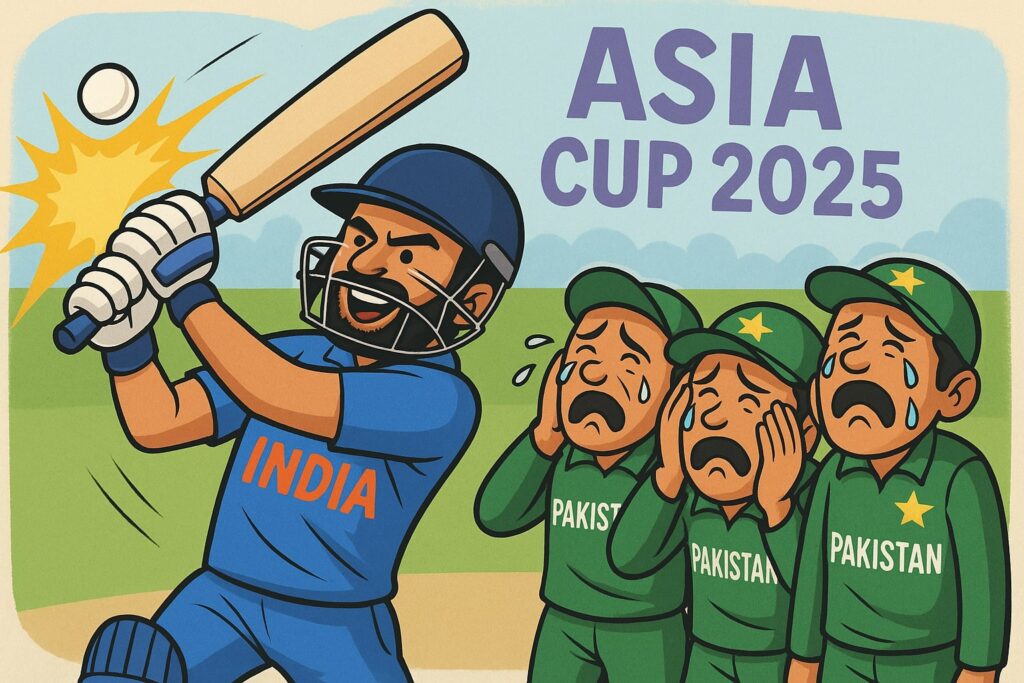The Asia Cup final between India and Pakistan will go down as more than just a cricket match. It became the climax of a month where handshakes were weaponised, imaginary guns were fired, jets were shot down in mime, and cups of invisible tea were sipped.

Pakistan barked loud enough for the world to hear. But as the dust settles, it’s India’s calm, clinical cricket that has left the bite marks.
The handshake that never was
The first collision between the two sides in the group stage was supposed to be straightforward. Instead, it opened the floodgates of drama. India won with ease, but it was the refusal to shake hands that stole the spotlight.
Suryakumar Yadav, captaining the side, declared the win a tribute to the victims of the Pahalgam attack and to India’s armed forces. For Pakistan, the snub felt like salt rubbed on an old wound.
Well done, Team India! After thrashing Pakistan, the Indian team didn’t even come out to shake hands with the losing side, as is customary.
— Amit Malviya (@amitmalviya) September 14, 2025
The best part: Captain Suryakumar Yadav expressed solidarity with the families of the victims of the Pahalgam terror attack. He dedicated… pic.twitter.com/MlAC8axCGa
The fallout was immediate. Pakistan coach Mike Hesson voiced disappointment, captain Salman Ali Agha skipped the presentation, and the PCB lodged a formal complaint.
Soon, whispers of a boycott began circulating, with Pakistan threatening to sit out unless match officials were changed. One game was even delayed while the board debated its options. But in the end, pragmatism trumped pride.
Forfeiting would have meant heavy fines and sanctions, and Pakistan stayed put. The tournament rolled on, but the stage was already set for something more volatile.
Guns, jets and a daddy in the house
When the two sides met again in the Super Four, Pakistan decided to answer India’s cold shoulder with theatre. Sahibzada Farhan marked his half-century by pointing his bat like a gun and pretending to fire at the stands. Haris Rauf followed with a “6–0” finger gesture and a crashing jet mime, a throwback to military bragging rights rather than cricketing ones.
Haris Rauf silences the Indian crowd with a bold 6-0 gesture pic.twitter.com/eaCVvyEthm
— Thakur (@hassam_sajjad) September 21, 2025
But nothing undercut bravado quite like Abhishek Sharma. The young left-hander tore into Pakistan’s bowlers with a fearless 74 off 39 balls. Sixes rained, boundaries flew, and by the time he walked back, India had all but sealed the chase.
On social media, the nicknaming factory went into overdrive: Abhishek was anointed “Abu Sheikh Sharma — the new Daddy of Pakistan.” In one night, he became both meme and menace. Pakistan had the gestures; India had the scoreboard.
When the referee brings out the whistle
The ICC was never going to let this slide. Rauf’s antics cost him 30 percent of his match fee, Farhan was handed a warning, and even Suryakumar found himself docked for his earlier remarks about dedicating a win to the armed forces. The BCCI lodged complaints, the PCB countered, and paperwork piled up faster than runs on the board.
Pakistan’s captain, Salman Agha, doubled down. He told his players to keep their aggression alive, insisting it was part of their identity.
His chairman tried to argue Rauf’s gesture was harmless by posting Cristiano Ronaldo videos online. But the optics were clear. When you’re forced to explain that your finger signals are just football celebrations, you’ve already lost the PR battle.
The drama goes cross-sport
Soon, the theatrics spilled beyond cricket. At a South Asian football youth clash, a Pakistani U-17 striker sat down by the corner flag and mimed sipping tea, a cheeky nod to the Abhinandan saga of 2019.
India, however, won the match 3–2. In women’s cricket, Pakistani spinner Nashra Sundhu was filmed flashing a “six” celebration after a dismissal, as if determined to prove that gestures were now the national export.
When you can’t win on the field, you sip on fantasies — Pak U17 striker’s ‘tea’ act proves it again. #India #IndianFootball #PAKvIND pic.twitter.com/pSABCZ786H
— Amit Shukla (@amitshukla29) September 23, 2025
And on social media, it all turned into open season. Clips of Farhan’s gunfire were remixed to comic effect. Rauf’s “6–0” was memed into oblivion. Abhishek Sharma was crowned the Internet’s newest overlord, with reels showing him bossing bowlers like a video game cheat code. For every gesture Pakistan threw out, India replied with a viral punchline — and a win.
Silence is golden, runs are louder
What emerged was a sharp contrast. Pakistan reached for noise, theatre and political symbolism. India stayed icy. Even Suryakumar’s declaration that “India–Pakistan is no longer a rivalry” carried the chill of someone who knows he has the upper hand.
Rivalries, after all, require balance. This one, on current form, looks anything but balanced.
India kept their heads down, stacked up victories, and moved on. Pakistan, weighed down by their own gestures, looked like a side caught playing to the cameras rather than the scoreboard. In cricket, the scoreboard is the only judge that matters. And it was merciless.
The final scene
Now, with the final just hours away, the theatre is at its peak. Salman Agha insists his team won’t tone down. India walks in with quiet confidence. The fans are baying, the memes are primed, the cameras ready to catch the next outburst. But once the first ball is bowled, theatre counts for nothing.
If Pakistan wants to win, it will take more than imaginary rifles and cups of invisible tea. It will take runs, wickets and calm. Otherwise, the Asia Cup of 2025 will be remembered for one truth above all: Pakistan barked, India bit.


